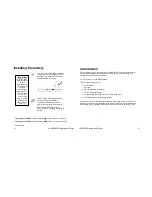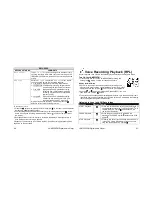
MP3 and WMA Audio
Perhaps the most popular attribute of your JX-MP256FM is its small size and its ability
to store and play a number of musical selections. Unlike the Voice Recorder, the
music stored within the unit is not recorded with the microphone, but is transferred
(
downl
oaded)
f
r
om
el
ect
r
oni
c
musi
c
f
i
l
es
al
r
eady
st
or
ed
on
your
PC’
s
har
d
dr
i
ve.
Typically, most music files contain lots of content and, as a result, can be rather large
–
but
because
of
t
oday’
s
t
echnol
ogy
,
i
t
’
s
possi
bl
e
t
o
compr
ess
or
“
squeeze”
many
audi
o
files into less than 1/10 their original size, without damaging them or affecting their
“
l
i
st
en
-
abi
l
i
t
y”
.
Thi
s
smal
l
si
ze
not
onl
y
makes
t
hem
easy
t
o
st
or
e,
but
equal
l
y
easy
t
o
distribute and obtain over the Internet.
File Formats
MP3s
The two most popular file types for compressed digital audio are called MP3 and
WMA. MP3 (short for Motion Picture Experts Group
–
Audio Layer 3) is the file format
chiefly responsible for the popularity of digital music on the Internet, and for the
advent of the many popular audio players like your JX-MP256FM. Even though the
size of an MP3 file is only about 10% the size of the file its content is derived from, its
sound quality compares very favorably with the original, and MP3 files are recognized
by virtually all media players.
WMAs
The other popular compressed audio file is called WMA (Windows Media Audio).
According to Microsoft, the developer of the WMA format, WMA music is supposed to
provide better sound in a smaller digital package than the equivalent MP3 files. While
WMAs are not as popular as MP3s, certain WMA files have the ability to protect the
artist because they allow musicians and their producers specify how their music is
used by applying user rights to the electronic licenses that determine just how and
where these WMA files may be distributed, played, and copied. This concept, known
as Digital Rights Management (DRM), should be understood if you plan to download
WMA music files that have restrictions on them. See page 28 for a discussion of
DRM.
-24-
JX-MP256FM Digital Audio Player
Sources of MP3s and WMAs
So where do you get your supply of digital music for your JX-MP256FM? One source
is the music found on regular CDs, whose tracks, as previously stated, are
substantially reduced in size once they are converted to the MP3 or WMA file formats.
This is done through the use of software applications that may already be resident in
your computer. Such software includes a process called
ripping,
in which the original
di
gi
t
al
audi
o
on
a
CD
i
s
t
r
ansf
er
r
ed
t
o
your
PC’
s
har
d
dr
i
ve,
and
t
hen
compr
essed
i
nt
o
the desired format. Once done, it can easily be downloaded to your digital music
player (see page 21), where it can be played.
Besides your own CDs, the Internet, of course, is clearly the chief source of digital
music, where MP3s and WMAs can easily be found and made available for immediate
downl
oadi
ng.
Thei
r
r
el
at
i
vel
y
smal
l
f
i
l
e
si
ze,
coupl
ed
wi
t
h
t
oday’
s
wi
despr
ead
use
of
high speed Internet connections, make acquiring compressed audio one of the most
popular Internet activities. The Internet is filled with sites that provide free, legal music,
along with many which allow you to acquire songs and complete albums for a nominal
fee, and even those which use subscription services for that purpose. The scope of
t
hi
s
manual
doesn’
t
per
mi
t
a
det
ai
l
ed
expl
or
at
i
on
of
obt
ai
ni
ng
I
nt
er
net
musi
c,
but
through the use of Internet search engines, magazine articles and books on the
subject, along with the help of friends and associates, you can soon be well on your
way to obtaining lots of music for your JX-MP256FM.
MP3/WMA ID Tags
Many
MP3
t
r
acks
avai
l
abl
e
f
r
om
t
he
I
nt
er
net
come
wi
t
h
an
el
ect
r
oni
c
“
I
D
t
ag”
(
cal
l
ed
an ID3) that contains information about the track
—
most importantly:
the Computer Filename (e.g. I Need You.mp3)
the Track Title (e.g. I Need You)
the Artist (e.g. America)
t
he
Al
bum
Name
(
e.
g.
Amer
i
ca’
s
Gr
eat
est
Hi
t
s)
Many ID tags contain additional information, which may include the year the song was
released, its length (mm:ss), technical data about its Bit Rate and Sampling (see
page
30)
and
somet
i
mes
even
i
t
s
l
yr
i
cs.
Because
of
t
he
si
ze
of
your
pl
ayer
’
s
LCD
display, only the most important information will be presented
—
thus, the Title and the
JX-MP256FM Digital Audio Player
-25-
















































